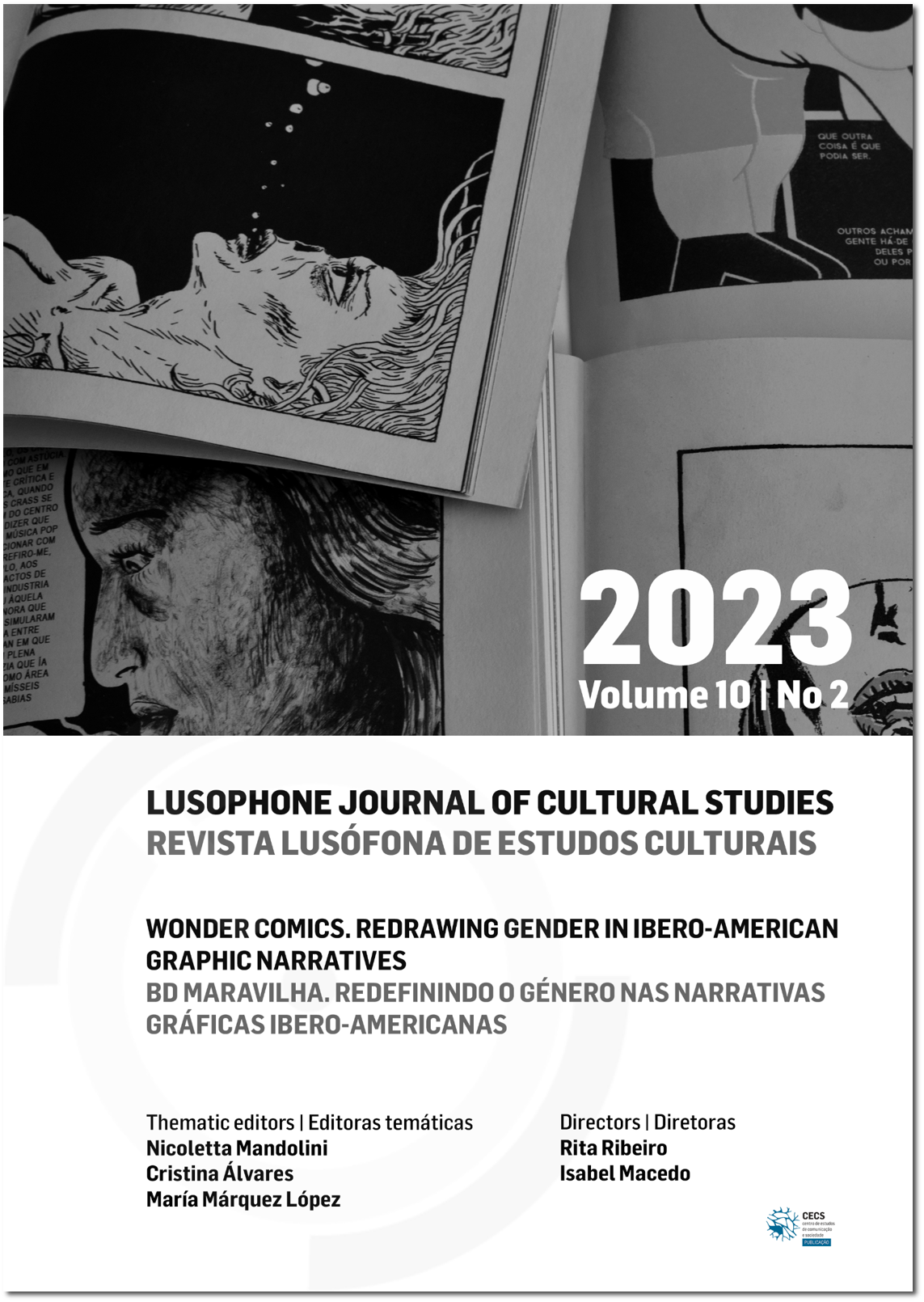Webs of Self, Webs of Meaning. Three Female Fragmentary Portraits in Post-Digital Print Comics
DOI:
https://doi.org/10.21814/rlec.4644Keywords:
experimental comics, counter-strategies, cuteness, animatedness, heteropathic identificationAbstract
The present paper analyses the work of three contemporary, independent women artists active in the Portuguese comics scene: Hetamoé, Joana Mosi, and Ana Margarida Matos. It provides a close formal reading of their work by following Peter Wollen's seminal article on counter-cinema. Despite the caveats of adopting whole cloth and in a clearcut manner notions from different media, there are enough commonalities and narratological features that provide stimulating comparisons. As in cinema, comics also have a broadly accepted normative understanding of comics' way of creating meaning, against which these three authors present what one can call, after Wollen, resisting formal strategies. Portuguese comics have had a troubled history, which entails a difficult economic development and the lack of wider social recognition (as a culturally relevant field). However, its most independent realms and sub-cultures have provided ample proof of engaged, informed, and inventive individual creators. Women creators are no exception to this, and this particular group shows three potentialities of opening up the field, both politically and aesthetically. Moreover, these same de/re/constructive strategies broach issues associated with identity, self-portrait, bodily matters, memory, and the very meaning-making processes at the core of their work. The feminist dimensions of their work, albeit quite varied, allow one to detect intense interpretations of the self and the role of womanhood in a broader process of self-actualization and social life. Thus, I will use Sianne Ngai's notions of "cuteness" and "animatedness" to understand the three author's specific manners of doing so, as depicted and constructed within the medium of comics.
Downloads
References
Aumont, J. (1990). L’image. Nathan.
Bell, J. (2020). Radical attention. Peninsula Press.
Bennett, J. (2005). Empathic vision. Affect, trauma, and contemporary art. Stanford University Press. DOI: https://doi.org/10.1515/9781503625006
Costa, S. F. (2022, October 20–30). 4 quartos. Amadora BD — Festival Internacional de Banda Desenhada, Amadora, Portugal.
Groensteen, T. (1999). Système de la bande dessinee. Presses Universitaires de France.
Hetamoé. (2012). Idle odalisque. Clube do Inferno.
Hetamoé. (2013). Onahole. Clube do Inferno.
Hetamoé. (2014). Yonkoma collection. Clube do Inferno.
Hetamoé. (2015a). They say that clovers blossom from promises. In QCDA 2000, (pp. 16–17). Chili Com Carne.
Hetamoé. (2015b). Obscure alternatives. In Clube do Inferno (Ed.), QCDI 3000 – FEAR OF A CAPITALIST
PLANET (pp. 3–8). Chili Com Carne.
Hetamoé. (2016). Muji life. Clube do Inferno.
Hetamoé. (2020). Violent delights. mini kuš!
Highmore, B. (2010). Bitter after taste. Affect, food, and social aesthetics”. M. Gregg & G. J. Seigworth (Eds.), DOI: https://doi.org/10.1215/9780822393047-005
The affect theory reader (pp. 118–137). Duke University Press.
Marx, K., & Engels, F. (2012). The communist manifesto (J. C. Isaac, Ed.). Yale University Press. (Original work published in 1848)
Matos, A. M. (2019). Passe social. Erva Daninha.
Matos, A. M. (2021). Hoje não. Chili Com Carne.
Matos, A. M. (2023a, 4 de março – 27 de abril). Da minha janela à tua é uma palavra de distância. Unpublished one-pager piece [Poster presentation], Janela Discreta, Livraria Barata/Lugar de Cultura, Lisboa, Portugal.
Matos, A. M. (2023b). Grapefruit. mini kuš!
Matos, A. M. (2023c). Untitled. Stripburger # 80, 8–15.
McCloud, S. (1993). Understanding comics. The Invisible art. Kitchen Sink.
Mosi, J. (2021a). Both sides now. Associação Ao Norte.
Mosi, J. (2021b). My best friend Lara. Self-published.
Mosi, J. (2022a). The apartment. mini kuš!
Mosi, J. (2022b, October 20–30). Plan a party and we’ll tell you what cake you are! Unpublished 10-page
comic [Poster presentation]. Amadora BD — Festival Internacional de Banda Desenhada, Amadora, Portugal.
Mosi, J. (2023). Postal dos correios. Limoeiro Real, III, 44–51.
Moura, P. (2008). Memória na banda desenhada: Presença e leituras da memória em sete casos da banda desenhada contemporânea francófona [Master’s dissertation, Universidade Nova de Lisboa]. RUN – Repositório Universidade Nova. http://hdl.handle.net/10362/82178
Moura, P. (2022). Visualising small traumas. Contemporary Portuguese comics at the intersection of everyday DOI: https://doi.org/10.1353/book.109373
trauma. University Press of Leuven.
Ngai, S. (2005). Ugly feelings. Harvard University Press. DOI: https://doi.org/10.4159/9780674041523
Ngai, S. (2012). Our aesthetic categories. Zany, cute, interesting. Harvard University Press.
Orbán, K. (2014). A language of scratches and stitches: The graphic novel between hyperreading and print. Critical Inquiry, 40(3), 169–181. DOI: https://doi.org/10.1086/677340
Schneider, G. (2016) What happens when nothing happens. Boredom and everyday life in contemporary comics. Leuven University Press.
Sousa, A. M. (2020). CUTENCYCLOPEDIA: A theoretical-practical investigation on the kawaii as an aesthetic
category in art and pop culture [Doctoral thesis, Universidade de Lisboa]. ULisboa – Repositório da Universidade de Lisboa. http://hdl.handle.net/10451/45935
Trites, R. S. (1997). Waking leeping beauty: Feminist voices in children’s novels. University of Iowa Press. DOI: https://doi.org/10.1353/book17661
Wollen, P. (1972). Godard and counter cinema: Vent d’Est. Afterimage, (4), 6–17.
Žižek, S. (2008). The plague of fantasies. Verso.
Downloads
Published
How to Cite
Issue
Section
License
Copyright (c) 2023 Pedro Moura

This work is licensed under a Creative Commons Attribution 4.0 International License.
Authors own the copyright, providing the journal with the right of first publication. The work is licensed under a Creative Commons - Atribuição 4.0 Internacional License.












